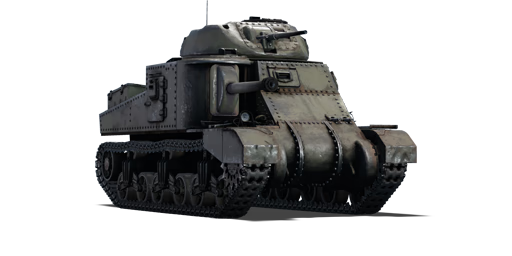


The Grant I is a premium gift British medium tank. It was introduced during Update 1.61 "Road to Glory" as an reward vehicle for the 2016 Operation S.U.M.M.E.R. event. It is identical to the Grant I (USA), which itself is nearly identical to the M3 Lee with the difference being in the turret design.
The Grant is most well recognized for its tall profile and two cannons. The suspension resembles that of the M4 Sherman, the only notable difference being the return rollers' positions. The hull front is also stepped into two plates, where the upper is closer to vertical. The large sponson on the right side (if you are inside it) carriers the main 75 mm gun; note that with 2 crew members, it is the operational gun. The 37 mm gun is in a turret, mounted with a leftward offset. Its main notable difference from the M3 Lee is a redesigned turret.
Due to the presence of two cannons, this tank is an excellent multi-role vehicle. You can play it as a brawler combining the agile 37 mm gun with the high damage of the 75 mm gun, but don't get too close, in fact, the turreted gun has a bad depression and, combined with the high profile, tends to make close tanks difficult to hit. You can also play it as a tank destroyer using it from the second line. Note that you can assign a key to use only one of the two guns, with this method you can select as a primary weapon the 75 mm gun, allowing you to aim directly from it (and not from the point of view of the 37 mm gun) and use the bullet drop indicator in arcade battles.
The multiple cannons allow for different combinations of attack. The 75 mm gun possesses armour penetration on about the level of the 37 mm gun; however, the damage upon penetration is extremely high provided that you use the M61 APCBC shell with HE filler. On the other hand, the 37 mm gun allows for close quarters and longer-range fighting, where its high-velocity and effective shell make for good long range targeting while it is also the only cannon on the Grant that has a full 360-degree traverse.
| Ammunition | Type | Armor penetration (mm) at a distance: | |||||
|---|---|---|---|---|---|---|---|
| 10 m | 100 m | 500 m | 1000 m | 1500 m | 2000 m | ||
| AP | 84 | 82 | 72 | 62 | 53 | 46 | |
| HE | 10 | 10 | 10 | 10 | 10 | 10 | |
| APCBC | 97 | 95 | 87 | 78 | 70 | 63 | |
| Smoke | 3 | 3 | 3 | 3 | 3 | 3 | |
| Ammunition | Type | Armor penetration (mm) at a distance: | |||||
|---|---|---|---|---|---|---|---|
| 10 m | 100 m | 500 m | 1000 m | 1500 m | 2000 m | ||
| AP | 79 | 76 | 65 | 54 | 45 | 37 | |
| APCBC | 87 | 84 | 73 | 60 | 50 | 41 | |
| Belt | Belt filling | Armor penetration (mm) at a distance: | |||||
|---|---|---|---|---|---|---|---|
| 10 m | 100 m | 500 m | 1000 m | 1500 m | 2000 m | ||
| AP/T | 13 | 12 | 7 | 3 | 2 | 0 | |







 2 x (40 / 50 / 60) %
2 x (40 / 50 / 60) % 
 2 x 118 %
2 x 118 % 

Mobility | |
|---|---|
Protection |
|---|
Firepower | |
|---|---|
